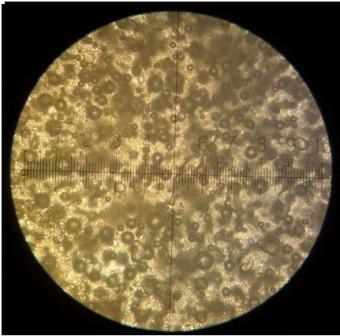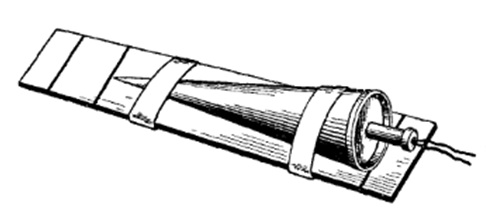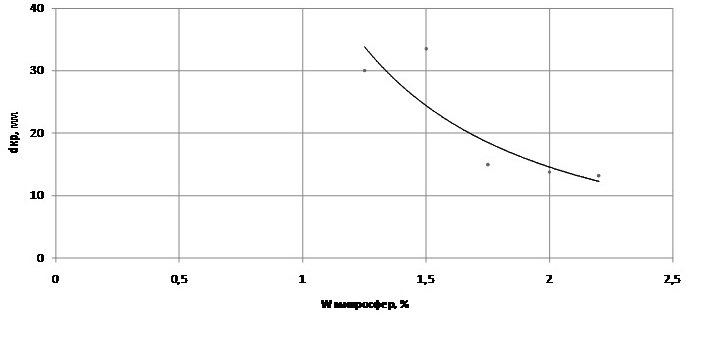Abstract
Content
- Introduction
- 1. Theme urgency
- 2. Goal and tasks of the research
- 3. The scientific novelty of the work
- 4. The structure of the emulsion explosives
- 5. Methods of sensitizing of the emulsion matrix
- 6. Determining the influence of the sensitizer (glass microspheres) on the critical detonation diameter
- 6.1 The experiment
- 6.2 The results
- Conclusion
- References
Introduction
Blasting operations became a great part of modern manufacturing processes in many industries.
A huge share of industrial explosives spend explosions in mining. The destruction of species by the help of the explosion energy is universal and almost the only highly effective way to prepare rocks to the grooving.
The most currently used explosives are highly sensitive to mechanical stress, toxic and emit a large number of toxic gases (CO, NOx), and therefore pose a serious threat to people and the environment, both in manufacture and in use.
Due to intensive research of the XX century on the theory of detonation, a new type of industrial explosives (emulsion explosives) was developed.
1. Theme urgency
Emulsion explosives have many advantages.
- They do not contain explosive materials.
- Become explosive in the final stages of preparation.
- They do not contain toxic materials.
- They are not very sensitive to friction, impact, open flames and other physical treatments, providing safe transportation and handling.
- They are waterproof.
- Environmentally friendly because the products of explosion contain water vapors, carbon dioxide and free nitrogen.
- Produced from domestic raw materials, which greatly reduces their value.
A number of significant advantages gave them the opportunity to find wide application in industry, both abroad and in our country.
2. Goal and tasks of the research
Factors that influence on the detonation properties of the of emulsion explosives:
- Type and amount of emulsifier, time of emulsification stirring speed.
- Type and amount of sensitizer.
- Energy additives.
All elements of explosives must be coordinated and matched.
The aim of this work is to establish the influence of various sensitizers on detonation characteristics of emulsion explosives, choosing the most effective sensitizer and to determine its optimal amount.
To achieve this goal it is necessary to solve the following problem:
- To consider the the structure of emulsion explosives.
- To consider the types of sensitizing of the emulsion matrix.
- Choose the best method that is enable to determine the influence on the detonation characteristics of the sensitizer.
- Testing.
- To analyze the results.
- To choose the the most effective sensitizer and to determine its optimal amount in the emulsion explosives.
3. The scientific novelty of the work
The scientific novelty of the work is to study the influence of the type and amount of the sensitizer on the detonation characteristics of emulsion explosives.
4. The structure of the emulsion explosives
The basis of the emulsion explosives are inverse emulsion like water in oil
, that is a mixture of two liquids, practically insoluble in one another.
As the dispersion phase is used primarily aqueous solutions of mixtures of ammonium nitrate with nitrates of alkali and alkaline earth metals.
Continuous phase is formed by an oil products, mineral oils, waxes, paraffins in pure form or as mixtures thereof.
5. Methods of sensitizing of the emulsion matrix
Inverse emulsion due to the presence of a significant proportion of water (8-15%) did not find practical application without special treatment (sensibilization).
Methods of sensitizing of the emulsion matrix
6. Determining the influence of the sensitizer (glass microspheres) on the critical detonation diameter
6.1 The experiment
Detonation can be distributed on a charge of explosive without a solid shell only if the smallest its diameter is larger than a certain critical value.
The critical diameter is the most important characteristic of a detonation capabilities of explosives. Depending on its value is determined in the charges of which diameter this explosive can be used in blasting operations[2].
Determination of the critical diameter of explosives is reduced to finding the smallest diameter of the charge in which it is still possible stable detonation.
For the experiment was used emulsion explosives, consisting of a solution of ammonium nitrate and calcium, industrial oils, paraffin wax, an emulsifier and a sensitizer, in the form of glass microspheres.
The finished emulsion explosives under the microscope is shown in fig 1.
Figure 1 – Emulsion explosives under the microscope
It was received five explosive compositions containing glass microspheres: 1.25%, 1.50%, 1.75%, 2% and 2.2% (in excess of 100% of the basic structure).
Determination of the critical diameter was carried out by the method of conical charge. It were Made five charges in the form of cones(fig. 2).

Figure 2 – The conical charge with electric detonators
ПAfter the detonation of the charge was measured the distance from the vertex to the point where the trail ends with the mechanical action of the detonation products.

Figure 3 – Cone charge before the explosion

Figure 4 – The explosion of experimental samples
(Animation: 6 frames, 5 cycles of repetition, 344 kilobytes)
(xi – input signals, yi – code bits of the state zi – output signals)

Figure 5 – Cone charge after the explosion
Knowing the size of the cone before the experiment and measured distance was calculated diameter of the charge at the point where the detonation is stopped. This diameter is considered to be critical[3].
The results
The data obtained are presented in graphical form fig.6

Figure 6 – The dependence of the critical detonation diameter of the content of the microspheres
Conclusion
Studies have shown that increasing the content of the microspheres ("hot spots") leads to a reduction of the critical detonation diameter.
The obtained dependence shows that this change can be described by a power law. Mathematical treatment showed that the results described by the equation dkr=50,63 w-1,79. The correlation coefficient in this case is 0,796.
Based on these results, the optimum content of the microspheres is 1,75–2,0%. A further increase in their number causes an appreciable increase in the cost of emulsion explosives, but does not lead to a significant decrease of the critical diameter.
Research will be continued.
When writing this essay master work is not yet complete. Final completion: December 2012. The full text of work and materials on the topic can be obtained from the author or his head after that date.
References
- Генералов М.Б. Основные процессы и аппараты технологии промышленных взрывчатых веществ: учебное пособие для вузов/ Генералов М. - М.: ИКЦ «Академкнига», 2004. -397с.: ил.- ISBN 5-94628-130-5
- Гольбиндер А.И. Лабораторные работы по курсу теории взрывчатых веществ/ Гольбиндер А.И. - М.:Госвузиздат,1963.-142с.
- Шевцов Н.Р., Калякин С.А., Левит В.В Практикум по взрывному делу/ под ред. Шевцова Н.Р.- Донецк: Норд-Пресс, 2003.-95с.
- Илюхин В.С., Соснин В.А., Черемухина В.И., Макогон Л.В. Свойства матричных эмульсий и взрывчатых веществ на их основе / Горный журнал. – 2003. -№12.
- Буллер М.Ф. Промышленные взрывчатые вещества / Буллер М.Ф. - Суммы: СумГУ. -2009г. - 225с.
- Купрін В.П., Вілкул О.Ю., Іщенко М.І., Колтунов О.В. Оцінка детонаційних характеристик емульсійних вибухових речовин марки «Украйніт» та «Емоніт» / Купрін В.П., Вілкул О.Ю., Іщенко М.І., Колтунов О.В.- Информационный бюллетень УСИВ.-2012.-№4. [Электронный ресурс]. – Режим доступа: http://www.usiv.com.ua...
- Куприн В.П., Коваленко И.Л. О детонационных характеристиках эмульсионных взрывчатых веществ и гранэмитов / Куприн В.П., Коваленко И.Л. Информационный бюллетень УСИВ. - 2010.-№3. [Электронный ресурс]. – Режим доступа: http://www.usiv.com.ua...
- Шиман Л.Н. Безопасность процессов производства и применения на горных предприятиях эмульсионных взрывчатых веществ марки «ЕРА». / Шиман Л.Н. Диссертация на соискание ученой степени доктора наук. - Павлоград.-2010.-412с.
- Желтоножко А.А., Закусило В.Р. Состояние и перспективы развития промышленных взрывчатых веществ и средств инициирования в Украине и за рубежом / Желтоножко А.А., Закусило В.Р. - Информационный бюллетень УСИВ.-2009.-№3.[Электронный ресурс]. – Режим доступа: http://www.usiv.com.ua...
- Перспективы развития экологически чистых взрывчатых веществ угольных шахт Украины. [Электронный ресурс]. – Режим доступа: http://www.resurs.org.ua...
- Куприн В.П., Коваленко И.Л. О детонационных характеристиках эмульсионных взрывчатых веществ и гранэмитов / Куприн В.П., Коваленко И.Л. Информационный бюллетень УСИВ. - 2010.-№3. [Электронный ресурс]. – Режим доступа: http://www.usiv.com.ua...
